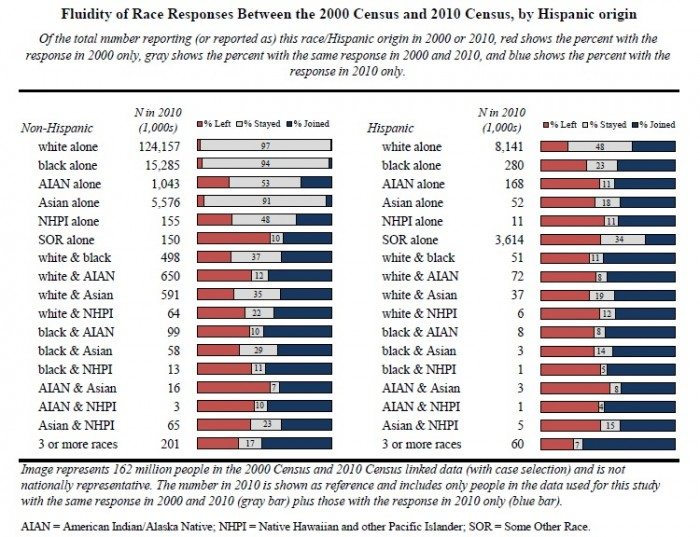Remember earlier this year when Nate Cohn of The New York Times let the world know that a significant number of U.S. Latinos were becoming more “white” by misrepresenting a study that had yet to be finalized?
This week that study was finally published. Here it is:
The researchers also wrote about the study on the official site of the U.S. Census. Here is a portion of what the group concluded:
We find that race and Hispanic origin responses changed for about 9.8 million people (or 6 percent). In the study, we estimate that about 8 percent would have changed their race or Hispanic origin between censuses if the study data were nationally representative.
We use the term “churning” to describe population turnover between census years — the number of people who left or joined a group relative to the number of people who stayed in the group. By using the linked data, we abstract from natural sources of churn such as births, deaths and migration and isolate churn due to response changes. Notably, across most types of response changes, we found that the (sometimes sizable) number of people joining each race/Hispanic group was similar to the number of people leaving the same group.
The table below shows churning and stability among single-race groups and multiple-race groups, by Hispanic origin. Responses changed across all race and Hispanic origin groups, especially among American Indians and Alaska Natives, Native Hawaiians and Other Pacific Islanders, people who reported multiple races, and Hispanics who reported a race. Responses were generally stable among single-race non-Hispanic whites, blacks, and Asians.
In general, people consistently report whether they are Hispanic. However, race responses among Hispanics were not as stable as among non-Hispanics. The two most common response changes were changing from “Hispanic Some Other Race” to “Hispanic White” and changing from “Hispanic White” to “Hispanic Some Other Race.”
Most of the common response changes involved adding or subtracting a race or Hispanic response. Many common response changes involved movement between the majority group and a minority group. And a number of people changed from one single-race group to another.
We conclude that a racial or ethnic group does not necessarily include the same individuals over time even if cross-sectional data show small net changes. Researchers who use race and Hispanic-origin information will need to take into account the possibility of response changes when interpreting results.
We wonder if Cohn will take back his initial reporting? He clearly only reported one part of the study and made some incredibly sweeping generalizations that never made sense to us. As we always expected, the conclusion was much more nuanced and complex. Cohn and the Times were irresponsible in pushing a narrative that quite frankly, was just a myth. But don’t take our word for it. Read what others had to say about it.




[…] Varela wrote Wednesday on Latino Rebels, pointing to the researchers’ latest work. “He clearly only reported one part of the study and made some incredibly sweeping generalizations that never made sense to […]